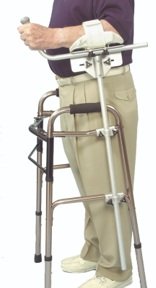Carpal Tunnel Surgery – What Should I Do?
Question: I had polio when I was 5. 36 years later, I discovered I needed additional support with a full left leg brace and assistive devices. I’ve also been diagnosed with arthritis and carpal syndrome.
Now 80, I have tingling sensations in the first three fingers of my right hand. My Family Physician suggested I contact an Occupational Therapist. Years ago, a fellow survivor years ago told me NOT TO HAVE Carpal Tunnel Surgery, but I didn't have a chance to learn why not. What do YOU advise?
Dr. Eulberg’s Response: It does sound like your symptoms could be from carpal tunnel syndrome. Did you have an EMG/Nerve Conduction Velocity test done? If so, and it clearly showed slowing of the nerve conduction at the wrist, the diagnosis is confirmed. If you use a cane, a crutch or a walker with some weight bearing on your right hand or if you use your hands to push off and get from sitting to standing, you will be advised to not use your hand/wrist to do these things during the post operative period (usually for about 10-14 days). This is an important part of your recovery, so you’d need to figure out how to deal with those restrictions. One option is to get an attachment for the walker (forearm support) that allows you to bear weight on your forearm but not on your wrist. There is also a similar crutch. These are frequently used by persons who need to use a walker or crutch/cane for some leg weakness but have recently broken their wrist/forearm/hand.
Here are two examples of “platform crutch attachments”.
There is no absolute reason that a polio survivor should not have carpal tunnel surgery if they have carpal tunnel syndrome. If the pressure on the median nerve through the wrist is severe enough it can lead to permanent paralysis of some muscles in the fingers and/or thumb in addition to the tingling and /or pain that occur when the nerve is partially compressed.
You need to make an informed decision, in consultation with your doctors about the pros and cons of various treatments for carpal tunnel syndrome. The one thing that is unique to polio survivors and others with leg weakness is the need to use their hands/arm for some activities that others can do entirely with their legs - that complicates how one cares for themselves as they recover from the surgery.
IF they decide to have surgery, polio survivors need to make their surgeon/anesthesiologist aware of any previous Anesthesia issues. For carpal tunnel surgery, most often the procedure will be performed until local or nerve block anesthesia and the patient will not need general anesthesia. The anesthesiologist/nurse anesthetist may use “conscious sedation” which means they will administer a mild sedative, so you are in “la-la” land but not fully unconscious. This would be similar to the “conscious sedation” used during a colonoscopy or cataract surgery. (If you have never had surgery or anesthesia of any kind, please let your surgeon know that you are a polio survivor). More information regarding surgery along with a card you can give to your physician is available.
I have seen several polio survivors who have had successful carpal tunnel surgery and did well, but it required some temporary change to their normal daily routine during the post-op period.



